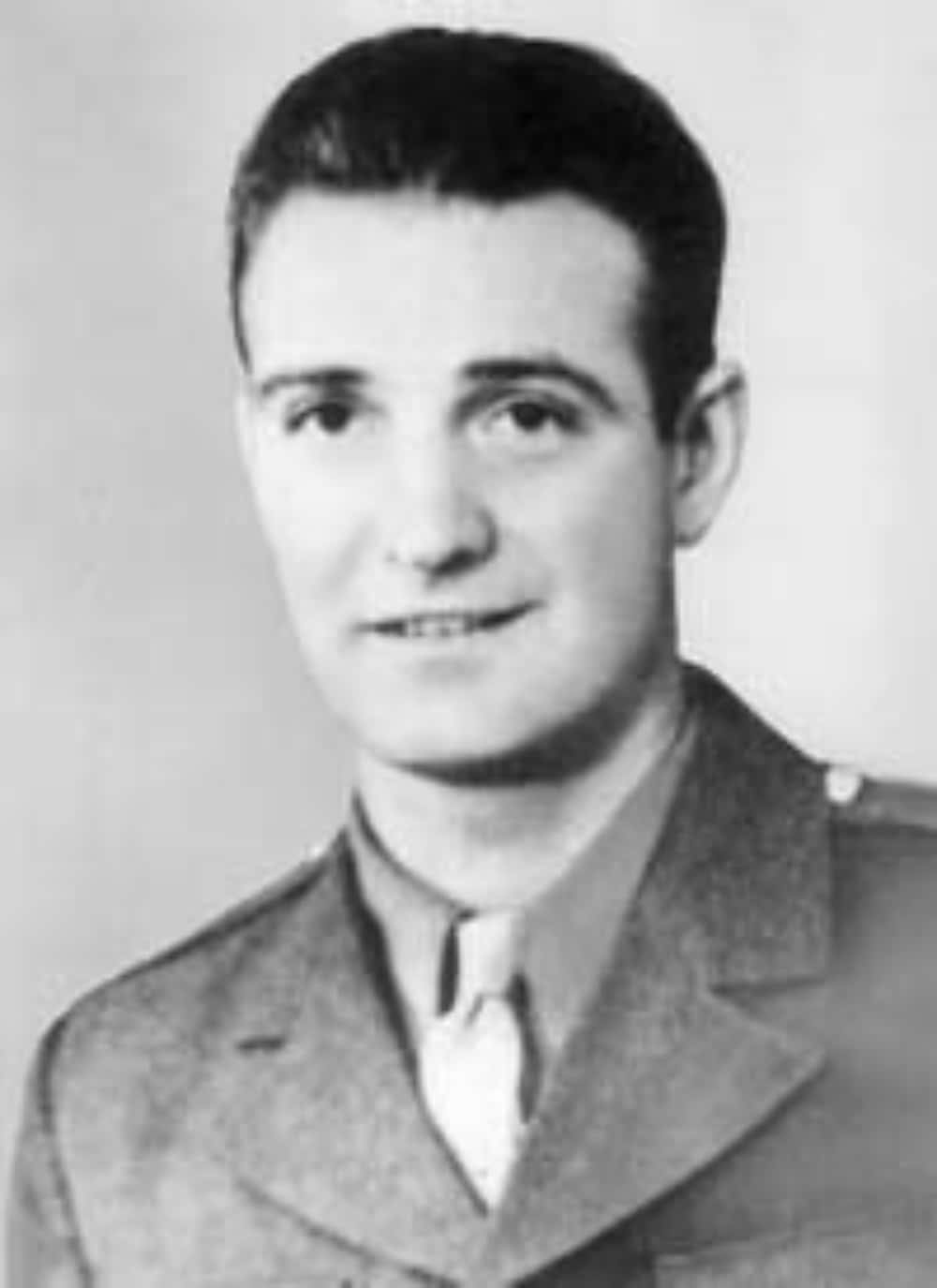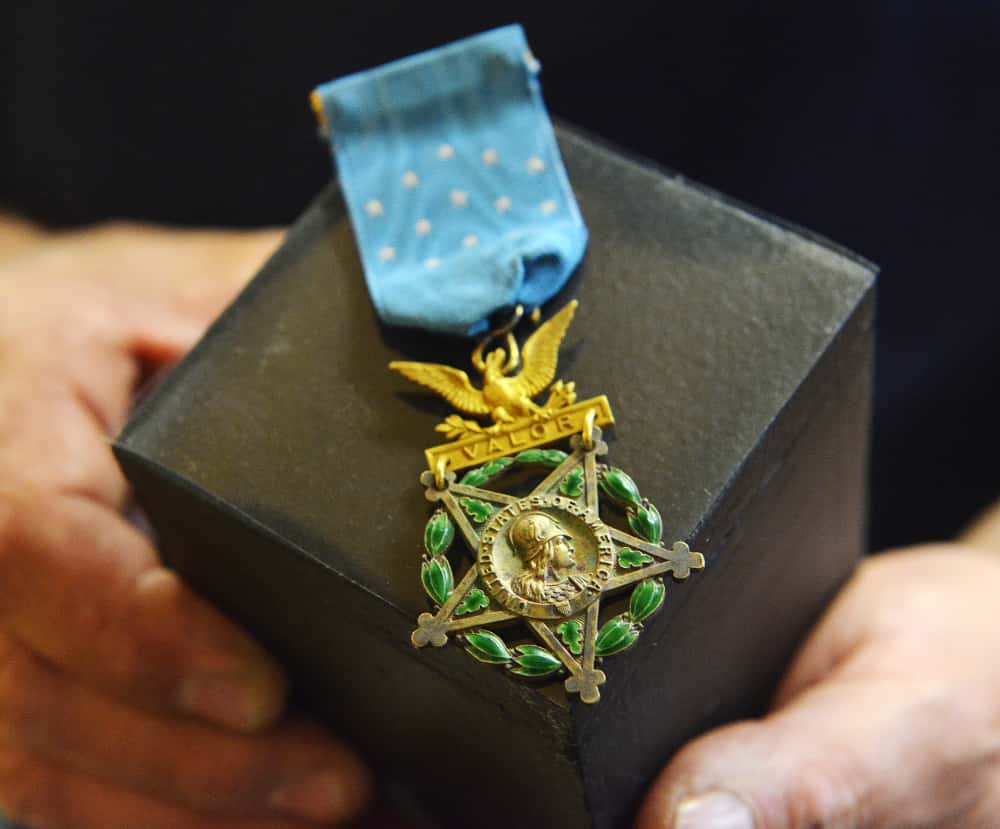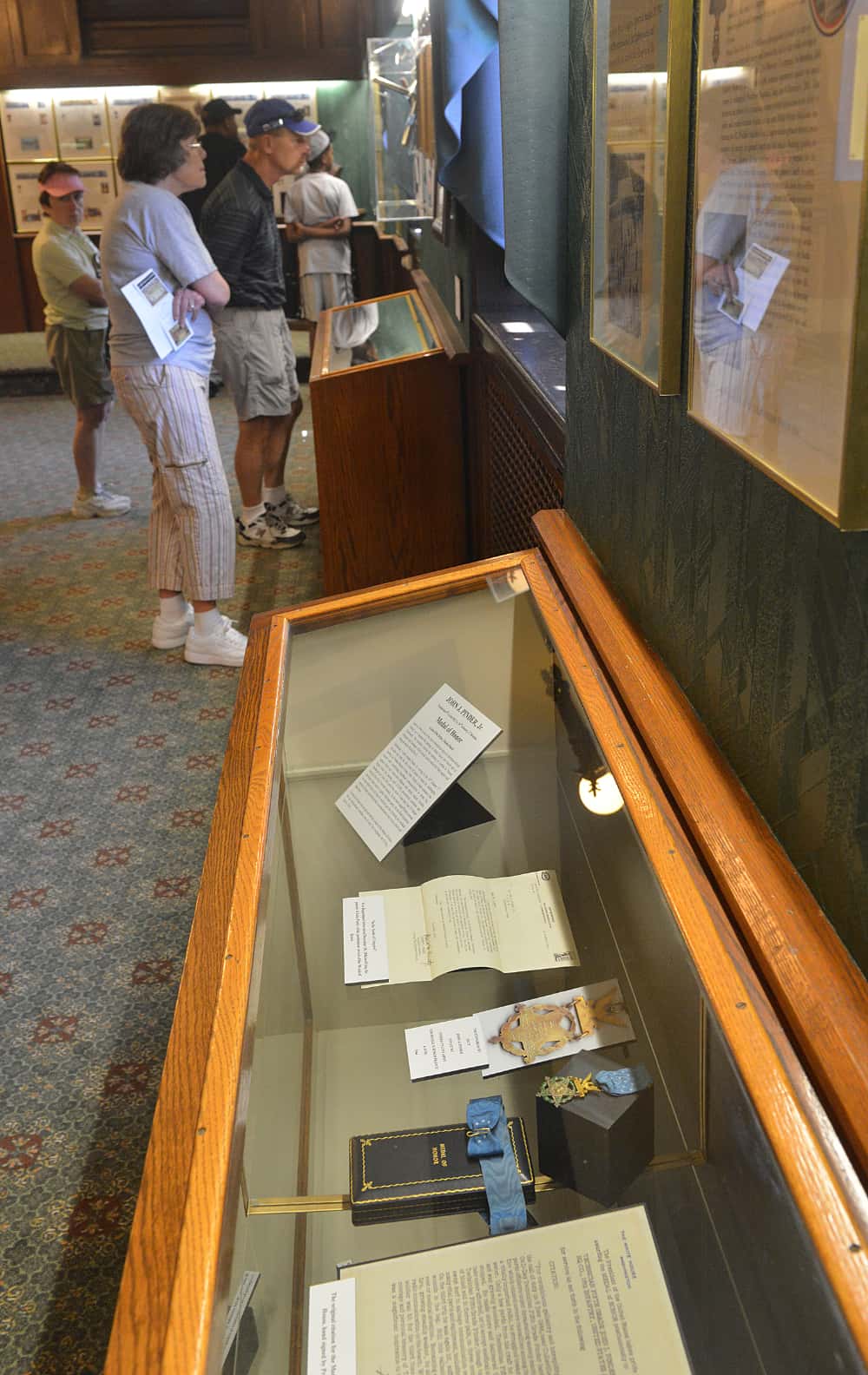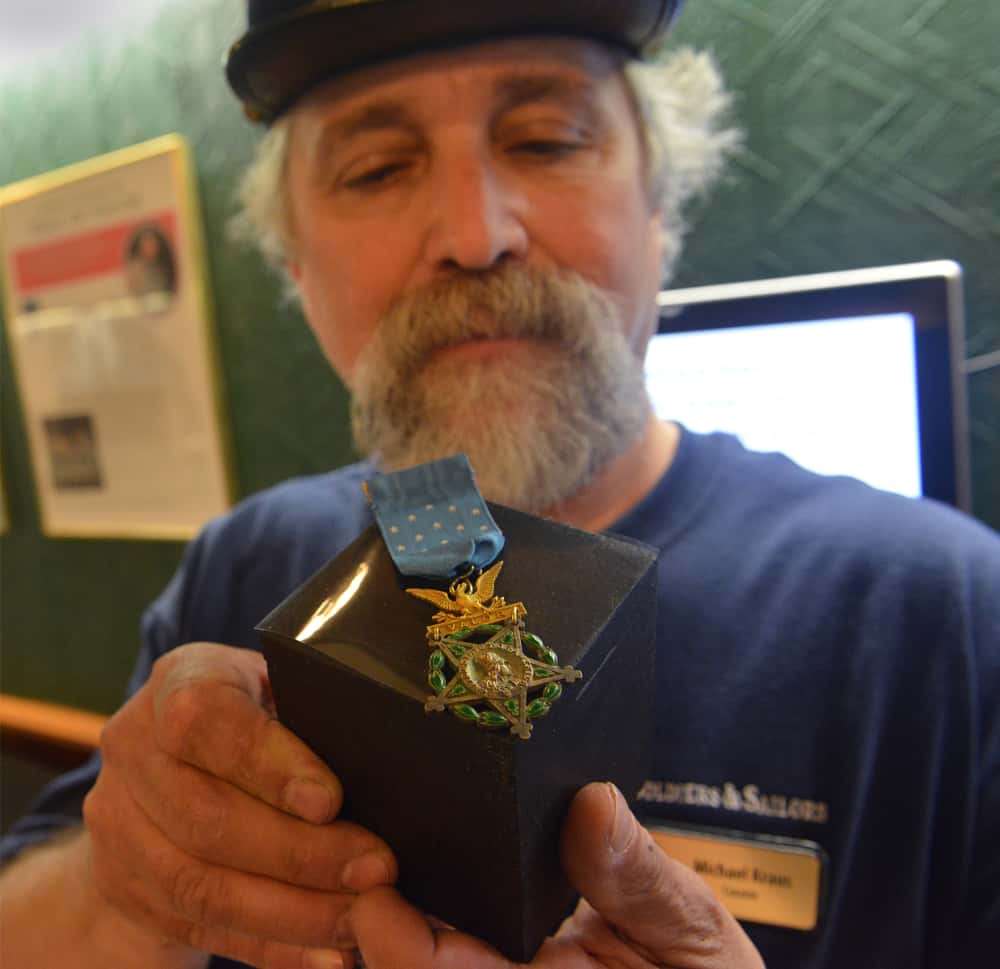Omaha Beach veteran's souvenirs are stark reminder of war
Seventy-five years ago today, June 6, 1944, the Allies stormed Normandy in the largest seaborne invasion in history. Eleven months later Nazi Germany surrendered and World War II in Europe finally ended after six brutal years.
Decades after the fighting, Gen. Omar Bradley reflected on what happened at the bloodiest landing site, Omaha Beach, where the Germans nearly pushed the Americans back into the sea.
"I have returned many times to honor the valiant men who died on that beach," he wrote. "They should never be forgotten. Nor should those who lived to carry the day by the slimmest of margins. Every man who set foot on Omaha Beach that day was a hero."
Harry Mistrik, a 5-foot-8, 134-pound kid from Rosetta Street in Garfield, fought on that beach.

Harry Mistrik, 96, holds a dagger he took off a German POW during World War II Thursday, Dec. 13, 2018, at a care facility in Hampton.
True to most World War II veterans, he doesn't consider himself a hero. But he did his duty with a combat engineer unit, wading ashore that day into the teeth of German machine guns and artillery to gain a desperate foothold on occupied France.
"I saw lots of people being hit. I saw hundreds being killed. They were lying all over the place," he says. "I figured if I got hit, I wouldn't know it. I just kept going."
Mr. Mistrik is 96 and living in a care home in Hampton.
For him, D-Day remains fresh, as does much of his combat experience in Europe and later in the Philippines. Like thousands of other ordinary young men, he fought across France and into Germany, then shipped off for the Pacific to finish the job there. When it was all over he came home and went to work. It's what everyone did.
"I wasn't proud of it," he says of his war experience. "I just figured I had to fight it."
He killed a lot of soldiers, he says, and he wasn't shy about taking souvenirs: Daggers, flags, swords, medals. It's the way it was in a war that left up to 85 million dead. A few years back he gave his collection to Soldiers & Sailors Memorial Hall & Museum, which keeps the items in a display case to commemorate one man's war.
"Landing on Omaha Beach on D-Day with the First Infantry Division, Harry was assigned the task of blowing up barbed wire barriers by using Bangalore torpedoes, thus creating openings for Americans to pass through," a plaque at the hall reads.
The description goes on to recount Harry's self-reported exploits - meeting George Patton, witnessing a massive tank battle, visiting a concentration camp and helping to blow up the giant swastika atop the stadium in Nuremberg where Hitler once held mammoth rallies.

This collection of World War II Nazi memorabilia sits in a glass case Thursday, April 25, 2019, at the Soldiers & Sailors Memorial Hall & Museum in Oakland. These artifacts were donated to the museum by Harry Mistrik, 96, of Hampton.
"Harry's war didn't end in Germany," the plaque says. "As a combat engineer he was scooped up to serve in the invasion of Japan, landing in the Philippines in 1945."
The atom bomb spared him the invasion. Japan surrendered Aug. 15 and he came home four months later to get on with life.
Born in 1923, Mr. Mistrik was one of 10 children. He was working at Jones & Laughlin Steel when the war came. Drafted in 1943, he trained as a combat engineer in Oklahoma and Texas, then shipped off to England in preparation for D-Day.
On June 6, combat engineers splashed ashore first because they had to clear obstacles. With Navy ships unleashing a deafening barrage, Mr. Mistrik waded in through waist-deep water into a storm of bullets.
"I had the Bangalore torpedo and I was supposed to knock out barbed wire and cut angles out," he said. "They were firing back, lots of bullets were coming."

In this photograph, Harry Mistrik, 96, of Hampton, sits on the wing of an American P-47 airplane in the Philippines in 1945. This photograph is part of a collection of World War II Nazi memorabilia that sits in a glass case Thursday, April 25, 2019, at the Soldiers & Sailors Memorial Hall & Museum in Oakland.
The torpedo was an explosive charge inside a long tube, used for clearing an area in advance of an infantry assault. Mr. Mistrik did his job and made it to the seawall, where soldiers hunkered down for protection.
"Someone [once] said to me, 'Were you afraid of being hit?' and I said, 'No, I was too busy,'" Mr. Mistrik recalls. "I didn't pay any attention to the bullets but I looked down and, boy, there were guys all lying on the beach. Lot of firing going on."
The fighting went on all day. But bit by bit, mostly through acts of individual courage, the Americans secured the beach and began the push inland to the hedgerow country — miles and miles of farm fields divided by ancient hedges.
"The hedgerows were very dangerous because they put machine guns in the corners," Mr. Mistrik remembers. Specially equipped tanks eventually cut through and the Allies began their advance across the French countryside.
Mr. Mistrik carried a rifle and says he could shoot well. Combat was often at close range. In one engagement, he volunteered to deliver a message to another headquarters unit. On his way back, he was crossing a field in the early morning when someone took a shot at him.
"A bullet went right past my ear," he says. "It made that cracking sound."
He dove over a mound of dirt and hid behind it. He saw a German soldier crawling up to his position, probably to see whether he was dead, every few seconds lifting his head up to get a better view.
"The last time he put his head up, I hit him in the side of the head" with a bullet, Mr. Mistrik says. "I killed lots of them."
Like soldiers anywhere, he took things from the enemy - lots of things.
At the French town of Metz, he saw two ceremonial swords hanging on the wall of a German headquarters building. He grabbed them. He took a Nazi flag from a house in another town, a dagger from a dead soldier, medals from prisoners.
The Battle of the Bulge proved to be a bonanza for souvenirs after the Germans began surrendering in large numbers. He took a pistol from a captured colonel.
After one mission behind enemy lines to blow up German bombers, a fighter plane swooped down and opened fire on him and his squad mates. They hid in some woods and watched as an American fighter swept in behind the German plane and shot it down. Mr. Mistrik walked over to the crash site and found the German pilot in some bushes.

This collection of World War II Nazi memorabilia sits in a glass case Thursday, April 25, 2019, at the Soldiers & Sailors Memorial Hall & Museum in Oakland.
"He was lying there and he was all mangled," he says. "He had a medal on his chest. I pulled that off him. A nice Air Force medal. I stuck it in my pocket."
One of Mr. Mistrik's strongest memories is Nuremberg in 1945. He said he climbed the balcony of the stadium and stood where Hitler once did. On the roof was a giant marble swastika. In a symbolic gesture, Mr. Mistrik and the combat engineers destroyed it.
"They blew it up," he says. "It came crashing down."
Mr. Mistrik was in Austria when the fighting in Europe ended. But his war went on.
"They said, 'Are you willing to go to Japan?' I said yeah."
His unit traveled back to France, boarded a ship and sailed to the Philippines. He saw more killing there and took more trophies as the war against Japan entered its final months.
Among his most gruesome experiences, he witnessed the fate of two Japanese soldiers accused of stealing corn from a Filipino. Someone shot them both and as they lay wounded, the local police chief approached with a machete and finished them off.
Mr. Mistrik was standing so close that blood spattered onto his boots.
"I'm amazed, you know,” he said of the executions.
Among his other items is a Japanese "comfort flag" he said he took from a dead soldier. The flags, inscribed with good luck messages from home, were carried by all Japanese into combat. Many U.S. soldiers took them from the dead during the war; in some cases their families have made efforts to return them to Japanese families of the slain.
This one, however, remains under glass at Soldiers & Sailors.
Mr. Mistrik said he sent all his souvenirs home from wherever he was.
"I wanted them, to show the family," he said.
He was gearing up for the invasion of the Japanese home islands when the U.S. dropped the bombs on Hiroshima and Nagasaki. In all, he had earned five battle stars for combat, four from Europe and one in the Pacific. He shipped home in December 1945.
Like most of the other 16 million U.S. servicemen, he went right back to work and started a family. He spent 42 years at J&L, retiring in 1982, and raised two children with his wife.
He kept his collection of war souvenirs until old age. In 2015, at age 92, he gave it to Soldiers & Sailors.










































Comments
Login Register Logout